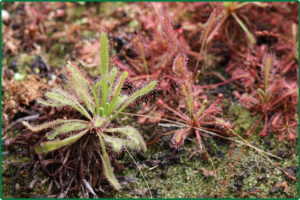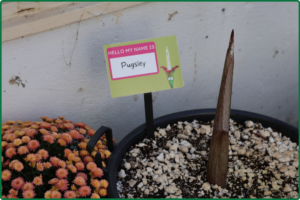Top 10 Things to See during Mutation Invasion: Flesh-eating Flora!
What happens when a mysterious meteor from outer space crash-lands in the Botanical Gardens’ collection of carnivorous plants? Find out at our newest exhibit, Mutation Invasion: Flesh-eating Flora! Keep your eyes peeled while you explore the conservatory, you don’t want a creeping carnivore to get the drop on you. Here are the top ten things to look for during this exciting carnivorous plant exhibit.
1. Venus flytraps

Venus Flytraps are the most active of our carnivorous plants. Their strong jaws can close in a flash, trapping any prey that lands on their tiny trigger hairs. Once their mouths snap shut, the long hairs along their lips tightly intertwine with each other, creating a vice grip that even the strongest of spiders can’t escape. Don’t let your fingers wander in to their trap!
2. Pitcher plants

Don’t fall down the Pitcher plant’s slippery slope, you might not be able to climb out! Their inner walls are covered in a waxy coating, making it difficult for prey to get a good enough grip to escape. A small pool of digestive liquid sits at the bottom of these tubular plants, which helps them break down all kinds of bugs and other small critters. These vining plants are native to subtropical areas, like Southeast Asia, Madagascar, and Australia.
3. Sundews

It might not have a mouth, but don’t let that fool you, the sticky Sundew is still very hungry. These plants are covered with sticky tubular hairs that sparkle in the sunlight. Bugs, mistaking the sparkling for drops of nectar, land on the hairs and get stuck! The sundews then secrete digestive enzymes and enjoy a buggy treat.
4. Mutation Invasion comic strip by Nate Phillips

The story of this invasion is on full display in comic book form! This comic, written and illustrated by Nate Phillips, details the adventures of Barry Burnham, a horticulturist for the Botanical Gardens who finds himself trapped in the conservatory with an army of mutated plants. How will he survive this terrifying evening? Find out in Mutation Invasion: Flesh-eating Flora!
5. Larger than life sculptures by Melanie Fisher

If the plants from the comic weren’t enough, there’s even more mutated spectacles to see thanks to a series of spooky sculptures! Made by local artist Melanie Fisher, these artistic representations of larger-than-life carnivorous plants are a sight to see. See her alien versions of Venus flytraps, Pitcher plants, Sundews, and more!
6. Flowering carnivorous plants

Did you know that even carnivorous plants like to look pretty every once in a while? Because these plants need to be pollinated, their flowers need to grow far away from their gaping mouths; they don’t want to accidentally eat one of their pollinators! To prevent this, their flowers often grow on tall stalks. Can you see any blooms on our carnivorous plants?
7. Mums

If carnivorous plants aren’t your jam, we’re still embracing the spirit of the season with tons of mums! See our large collection of colorful Chrysanthemums spread throughout our conservatory. They’re the perfect backdrop for Mutation Invasion, making the exhibit pop without stealing the spotlight.
8. Carnivorous Character Posters

Get to know the human, plant, and insect stars of our Mutation Invasion comic with the help of character posters! These large pieces of art highlight each major character and tell you a bit about their backstory and personality. Which character is your favorite?
9. Sphagnum moss

With an exhibit at huge as Mutation Invasion, you might expect to see a lot of dirt and soil for our plants. However, because most carnivorous plants grow in swamps, we plant them in a special mixture of sphagnum moss and perlite. This planting material mimics their wet habitats, which makes our mutated friends feel right at home in our conservatory.
10. Corpse plants

What’s that smell? It might be one of our corpse plants! These towering floras get their common name from the rotten stench that their flowers produce. The smell, that mimics decomposing flesh, attracts their main pollinators, flies! Corpse plants have a strange life cycle, alternating between periods of leafing, blooming, and dormancy. Our corpses plants are currently in the early stages of their leafing stage, but they’re still a sight to see.
See all of this and more during Mutation Invasion: Flesh-eating Flora. This creepy carnivorous exhibit is open daily through October 31.



